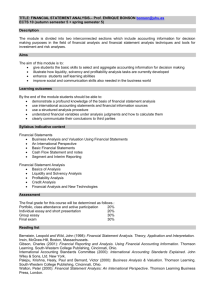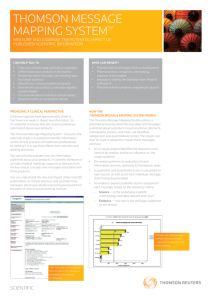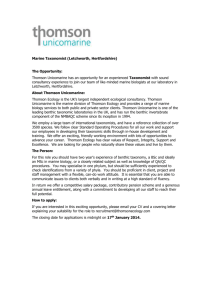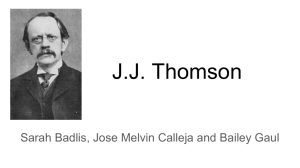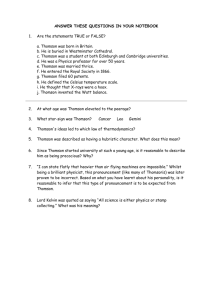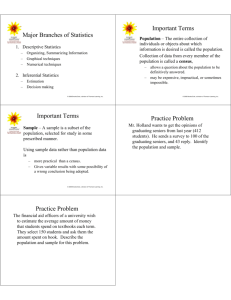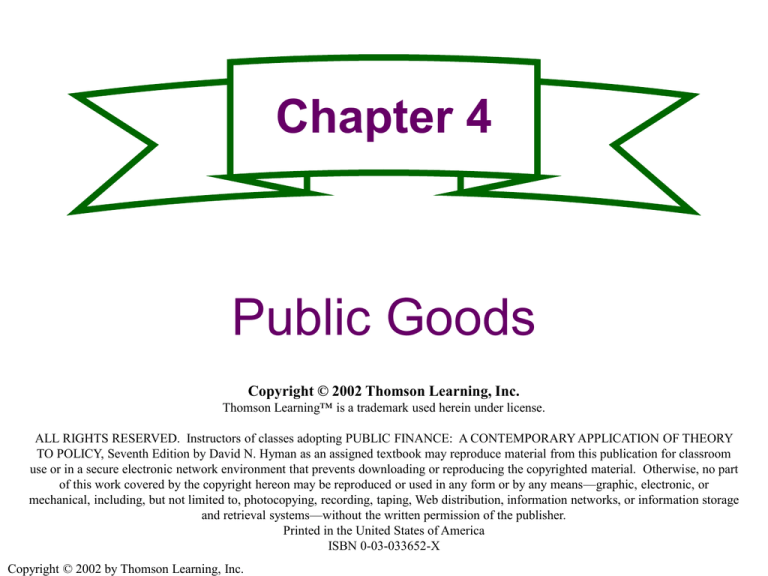
Chapter 4
Public Goods
Copyright © 2002 Thomson Learning, Inc.
Thomson Learning™ is a trademark used herein under license.
ALL RIGHTS RESERVED. Instructors of classes adopting PUBLIC FINANCE: A CONTEMPORARY APPLICATION OF THEORY
TO POLICY, Seventh Edition by David N. Hyman as an assigned textbook may reproduce material from this publication for classroom
use or in a secure electronic network environment that prevents downloading or reproducing the copyrighted material. Otherwise, no part
of this work covered by the copyright hereon may be reproduced or used in any form or by any means—graphic, electronic, or
mechanical, including, but not limited to, photocopying, recording, taping, Web distribution, information networks, or information storage
and retrieval systems—without the written permission of the publisher.
Printed in the United States of America
ISBN 0-03-033652-X
Copyright © 2002 by Thomson Learning, Inc.
Public Goods
Public Goods are goods for which
exclusion is impossible.
One example is National Defense: A
military that defends its citizenry from
invasion does so for the entire public.
Copyright © 2002 by Thomson Learning, Inc.
Characteristics of Public Goods
Nonexclusion: The inability of a seller to
prevent people from consuming a good when
they do not pay for it.
Nonrivalry: The characteristic that if one
person “consumes” a good, another person’s
pleasure is not diminished nor is another
person prevented from consuming it.
Copyright © 2002 by Thomson Learning, Inc.
Pure Public Goods and
Pure Private Goods
Pure Public Good: There is no ability to
exclude and there is no rivalry for the
benefits.
Pure Private Good: There is a clear
ability to exclude and there is rivalry for
the benefits.
Copyright © 2002 by Thomson Learning, Inc.
Marginal Costs for Provision of
Public Goods
The marginal cost of allowing
another person to benefit
from a pure public good is
zero while the marginal cost
of a greater level of public
good is positive.
Copyright © 2002 by Thomson Learning, Inc.
Figure 4.1 Marginal Costs of Consuming and Producing a
Pure Public Good-Figure A
Cost (Dollars)
200
Marginal Cost of Allowing an
Additional Person to Consume a
Given Quantity of Pure Public Good
0
1
Copyright © 2002 by Thomson Learning, Inc.
Number of Consumers
Figure 4.1 Marginal Costs of Consuming and Producing a
Pure Public Good--Figure B
Marginal Cost of Producing
a Pure Public Good
MC = AC
Cost (Dollars)
200
0 Units of a Pure Public Good per Year
Copyright © 2002 by Thomson Learning, Inc.
Example
Bread versus Heat
Bread – Clearly a pure private good
because there is the ability to exclude
and there is rivalry.
Heat – Clearly a pure public good
because there is no ability to exclude
and there is no rivalry.
Copyright © 2002 by Thomson Learning, Inc.
Provision of Private Good and
Public Goods: Markets and
Government
Price Excludable Public Goods
vs
Congestible Public Goods
Copyright © 2002 by Thomson Learning, Inc.
Price Excludable Public Goods
Excludability but no rivalry
Another type of good is a priceexcludable public good: no rivalry but
exclusion is easy.
Examples: Country Clubs, Cable TV
Copyright © 2002 by Thomson Learning, Inc.
Congestible Public Goods
Rivalry but no excludability
There are public goods where, after a
point, the enjoyment received by the
consumer is diminished by crowding or
congestion. These are called
Congestible Public Goods.
Examples: roads and parks
Copyright © 2002 by Thomson Learning, Inc.
Marginal Cost
Figure 4.2 A Congestible Public Good
Marginal Cost per User
0
1
Number of Consumers per Hour
Copyright © 2002 by Thomson Learning, Inc.
Table 4.1a Alternate Means of Producing, Distributing, and
Financing Goods and Services
CHARACTERISTICS
MEANS OF
OF THE GOOD OR
PRODUCTION
SERVICE
Pure Private Goods Privat e f irms;
No ext ernalit y;
government
low-cost exclusion
Price-Excludable
Public Goods
Ext ernal benef it s
when produced or
consumed; lowcost exclusion
MEANS OF
DISTRIBUTION
Market s; direct unit
charge
METHODS
PUBLIC
OF
EXAMPLE
FINANCE
Revenue
Food;
f rom sales clot hing;
cars
Government ;
privat e f irms
under cont ract
wit h government
No direct unit charge;
eligibilit y t o consume
various amount s
det ermined polit ically
Taxes
Privat e f irms;
government
Market s; direct unit
charge ( may be
subsidized)
Revenue
f rom
sales;
t axes
Government ;
privat e f irms
under cont ract
wit h government
No direct unit charge;
consumpt ion available or
required only at
collect ively chosen
quant it y and qualit y
Taxes
Copyright © 2002 by Thomson Learning, Inc.
Schools;
hospit als;
t ransport a
t ion
PRIVATE
EXAMPLE
Government
liquor st ores;
government
t obacco
monopoly
Government
dist ribut ion of
medical services
and f ood t o low
income cit izens
Transit f acilit ies;
public hospit als
Public schools;
public
sanit at ion;
inoculat ions
Table 4.1b Alternate Means of Producing, Distributing, and
Financing Goods and Services
CHARACTERISTICS
OF THE GOOD OR
SERVICE
Congest ible Public
Goods
Collect ively
consumed benef it s
subject t o
crowding;
possibilit y of
exclusion
Pure Public Goods
Collect ively
consumed benef it s
not subject t o
crowding; highcost exclusion
MEANS OF
PRODUCTION
MEANS OF
DISTRIBUTION
METHODS OF
FINANCE
Privat e f irms;
government
Fees f or t he right t o
use t he f acilit y sold in
market s
Revenue
f rom sales
Government ;
privat e f irms
under cont ract
wit h
government
1 . Privat e f irms;
government
2 . Government ;
privat e f irms
under cont ract
wit h
government
No direct user charge
( or part ial charge)
Taxes;
revenue f rom
sales
No direct unit charge;
quant it y dependent on
amount collect ed
No direct unit charge;
quant it y and qualit y of
service collect ively
chosen
Fees;
cont ribut ions
Taxes
Copyright © 2002 by Thomson Learning, Inc.
PUBLIC
EXAMPLE
PRIVATE
EXAMPLE
Clubs;
t heat ers;
amusement
parks;
sport ing
event s
Public golf
courses; roads
Public parks;
public recreat ion;
roads, bridges
Privat e
charit y
Public t elevision
and radio Nat ional
def ense;
environment al
prot ect ion
Figure 4.3 Classifying Goods According to the Degree of
Rivalry and Excludability of Benefits from Their Use
A
1
C
H
B
0
1
Rivalry
Copyright © 2002 by Thomson Learning, Inc.
Demand For a Pure Public
Good
Demand for a Pure Private Good is
derived by adding quantities at each
price.
Demand for a Pure Public Good is
derived by adding how much people will
be willing to pay at each quantity.
Copyright © 2002 by Thomson Learning, Inc.
Price per Loaf of Bread (Dollars)
Figure 4.4 Demand For a Private Good
7
6
5
4
E
3
S = MC = AC
D = QD
DC = MBC
DB = MBA
DA = MBA
2
1
0
1
2
3
4
5
6
7
8
9
Loaves of Bread Purchased per Week
Copyright © 2002 by Thomson Learning, Inc.
10
Marginal Benefit (Dollars)
Figure 4.5 Demand For A Pure Public Good
800
Z1
700
Z2
600
Z3
500
400
Z4
DA= MBA
DA = MBA
DB = MBB
DC = MBC
300
200
100
0
1
2
3
4
5
Security Guards per Week
Copyright © 2002 by Thomson Learning, Inc.
Marginal Benefit (Dollars)
Figure 4.6 Efficient Output for a Pure Public Good
800
700
600
E
500
MC = AC = MSB
400
DA= MBA = MSB
300
MBA
MBB
MBC
200
100
0
1
2
3
4
5
Security Guards per Week
Copyright © 2002 by Thomson Learning, Inc.
Efficient Output of a
Pure Public Good
The socially optimal level of the public good
requires that we set the Marginal Social
Benefit of that good equal to its Marginal
Social Cost. MSB = MSC
Lindahl Pricing: Everyone in a group
cooperates and pays their marginal benefit.
We can demonstrate this issue mathematically,
numerically (using a table), and graphically.
Copyright © 2002 by Thomson Learning, Inc.
Mathematically
Recall from Figure 4.5 that the marginal
social benefit for a pure public good is the
sum of the individual marginal benefits.
That is:
MSB = MB.
Efficient output is therefore:
MSB = MB = MSC.
Copyright © 2002 by Thomson Learning, Inc.
Numerically
Suppose we have three
people who are discussing
the issue of hiring security
guards. Note that each
person places a different
value on the levels of
security.
Copyright © 2002 by Thomson Learning, Inc.
A Numerical Example
Number of Security Guards per Week
1
2
3
4
MBA
$300
$250
$200
$150
MBB
$250
$200
$150
$100
MBC
$200
$150
$100
$50
MB
$750
$600
$450
$300
If the cost of security guards is $450 per week, then no individual will
hire even one guard, even though to group one is worth $750. The
group should hire three.
If they pay their marginal benefit, then three guards are hired. Person
A pays $600 ($200 per guard), person B pays $450 ($150 per guard)
and person C pay $300 ($100 per guard).
Copyright © 2002 by Thomson Learning, Inc.
The Peace Dividend
National Defense is the classic pure public
good.
Defense spending as a percentage of GDP
Fell from above 8 percent during the Vietnam era
to just above 5 percent in the late 1970s;
Grew during the Reagan defense buildup of the
1980s;
Fell below 5 percent with the demise of the Soviet
Union.
Copyright © 2002 by Thomson Learning, Inc.
Percentage of GDP
Public Policy Perspective: Defense Purchases as a
Percentage of GDP, 1966–1999
11
10
9
8
7
6
5
1966
1971
1976
1981
Year
Copyright © 2002 by Thomson Learning, Inc.
1987
1993
1999
Lindahl Equilibrium
The amount each person contributes, ti,
depends on their individual desires for
the public good.
The sum of the contributions equals the
total cost of the public good.
tiQ* = MC(Q*) = AC(Q*)
ti = MC = AC
All individuals agree to pay their share.
Copyright © 2002 by Thomson Learning, Inc.
Freeriding
Freeriding occurs when people
are not honest in stating their
Marginal Benefit because if they
understate it, they can get a
slightly reduced level of the public
good while paying nothing for it.
Copyright © 2002 by Thomson Learning, Inc.
Freeriding is easier with
Anonymity: If everyone knows who
contributes, there can be powerful social
stigmas applied to shirkers.
Large numbers of people: It’s easier to
determine the shirkers in a small group and
the punishment is more profound when
people close to you shun you.
Copyright © 2002 by Thomson Learning, Inc.
Illustrating Voluntary
Contributions to a Public Good:
The Gulf War
Under the premise that defeating Iraq in the
Gulf War was a public good to be consumed
by the industrialized economies and Arab
nations, each nation was expected to
contribute.
The U.S. and UK contributed the bulk of the
fighting forces.
Saudi Arabia, Kuwait, the UAE, Japan, and
Germany voluntarily paid $54 billion of the
estimated $61 billion cost.
Copyright © 2002 by Thomson Learning, Inc.

